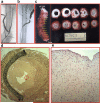The molecular mechanisms of hemodialysis vascular access failure
- PMID: 26806833
- PMCID: PMC4734360
- DOI: 10.1016/j.kint.2015.12.019
The molecular mechanisms of hemodialysis vascular access failure
Abstract
The arteriovenous fistula has been used for more than 50 years to provide vascular access for patients undergoing hemodialysis. More than 1.5 million patients worldwide have end stage renal disease and this population will continue to grow. The arteriovenous fistula is the preferred vascular access for patients, but its patency rate at 1 year is only 60%. The majority of arteriovenous fistulas fail because of intimal hyperplasia. In recent years, there have been many studies investigating the molecular mechanisms responsible for intimal hyperplasia and subsequent thrombosis. These studies have identified common pathways including inflammation, uremia, hypoxia, sheer stress, and increased thrombogenicity. These cellular mechanisms lead to increased proliferation, migration, and eventually stenosis. These pathways work synergistically through shared molecular messengers. In this review, we will examine the literature concerning the molecular basis of hemodialysis vascular access malfunction.
Keywords: arteriovenous fistula; murine model; restenosis; vascular biology; venous neointimal hyperplasia.
Copyright © 2016 International Society of Nephrology. Published by Elsevier Inc. All rights reserved.
Figures








References
-
- Sands JJ. Increasing AV fistulas: revisiting a time-tested solution. Semin Dial. 2000;13:351–353. - PubMed
-
- Roy-Chaudhury P, Lee TC. Vascular stenosis: biology and interventions. Curr Opin Nephrol Hypertens. 2007;16:516–522. - PubMed
-
- Rayner HC, Besarab A, Brown WW, et al. Vascular access results from the Dialysis Outcomes and Practice Patterns Study (DOPPS): performance against Kidney Disease Outcomes Quality Initiative (K/DOQI) Clinical Practice Guidelines. Am J Kidney Dis. 2004;44(suppl 2):22–26. - PubMed
-
- Vassalotti JA, Jennings WC, Beathard GA, et al. for the Fistula First Breakthrough Initiative Community Education Committee Fistula first breakthrough initiative: targeting catheter last in fistula first. Semin Dial. 2012;25:303–310. - PubMed
Publication types
MeSH terms
Grants and funding
LinkOut - more resources
Full Text Sources
Other Literature Sources
Medical

